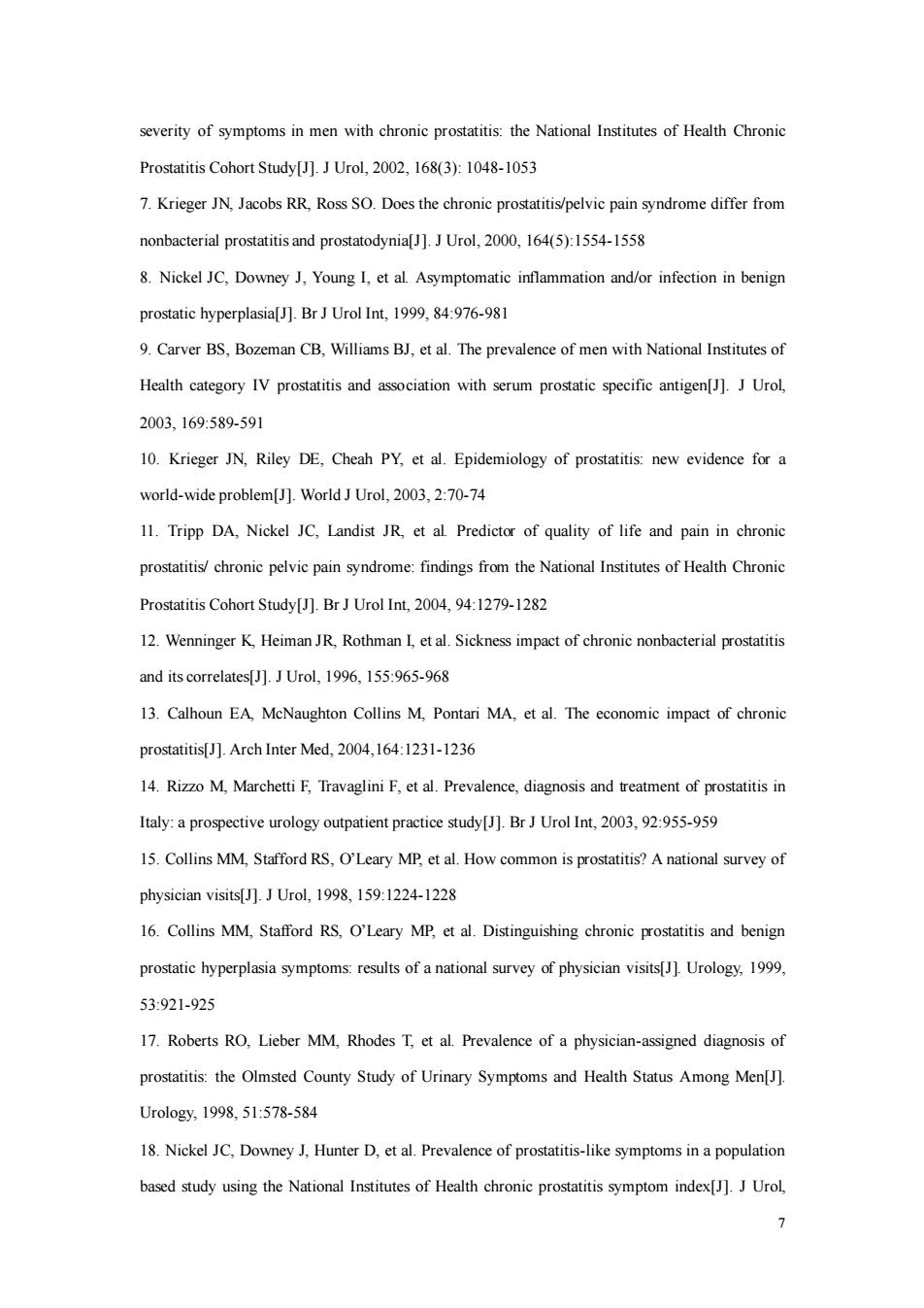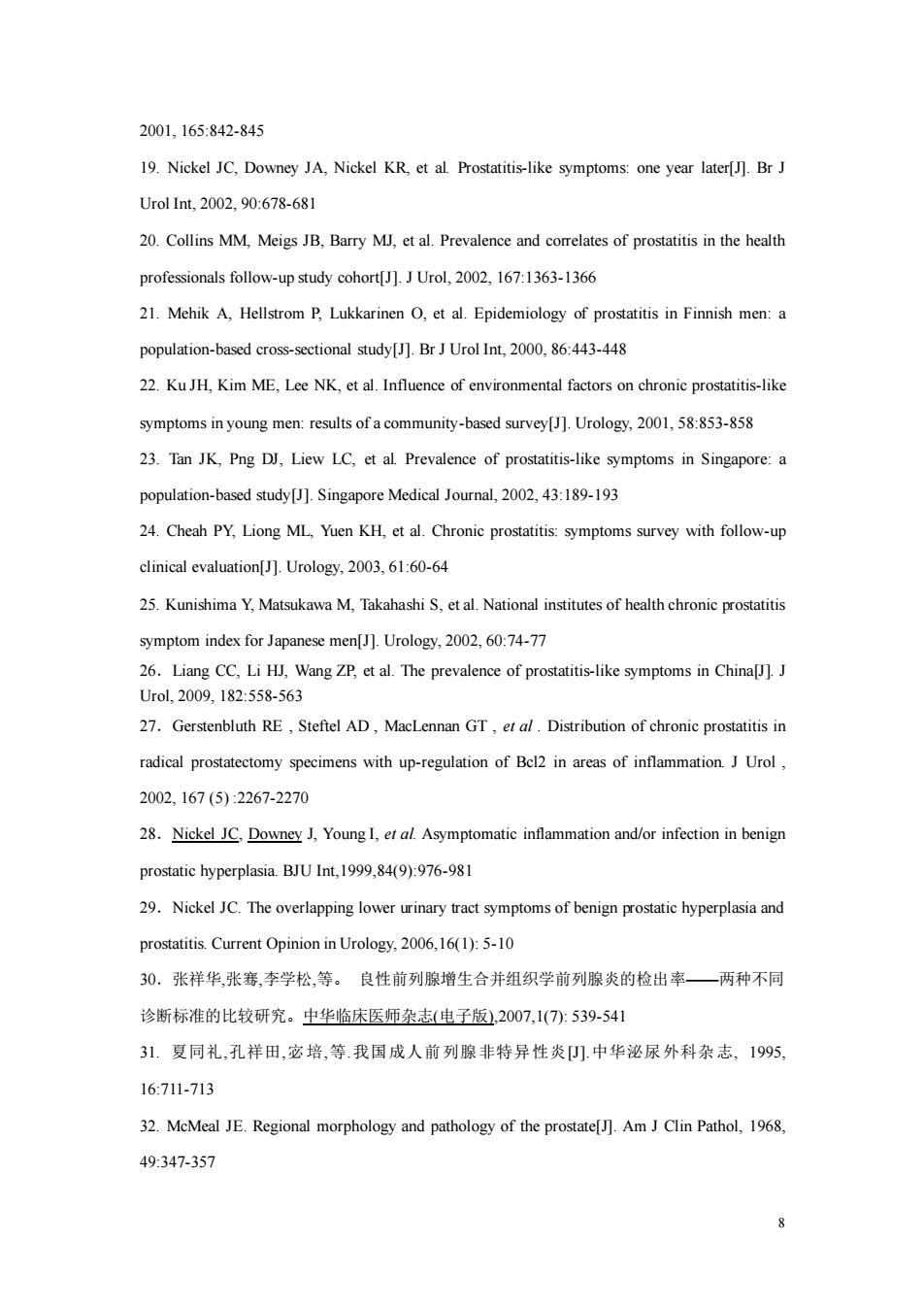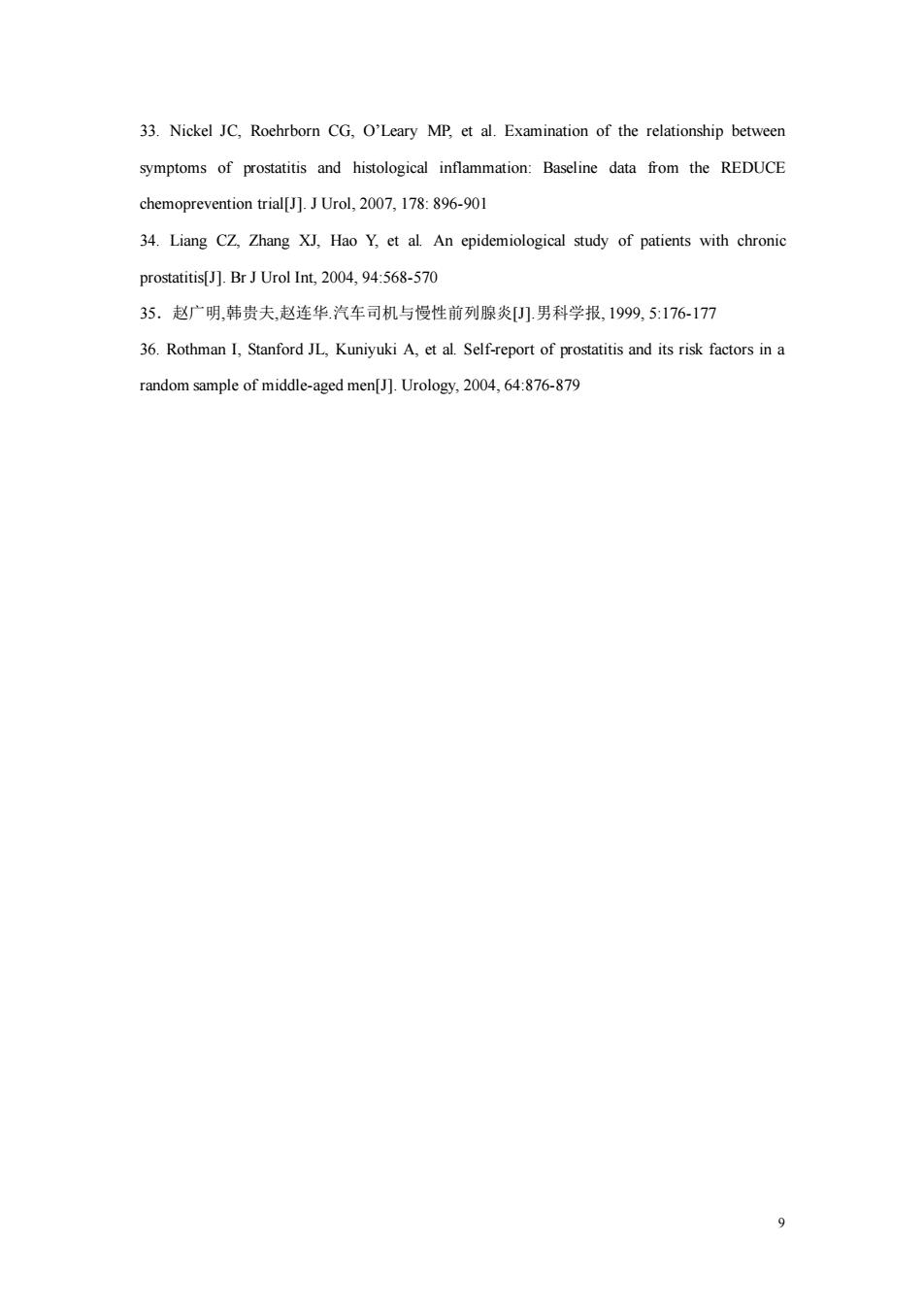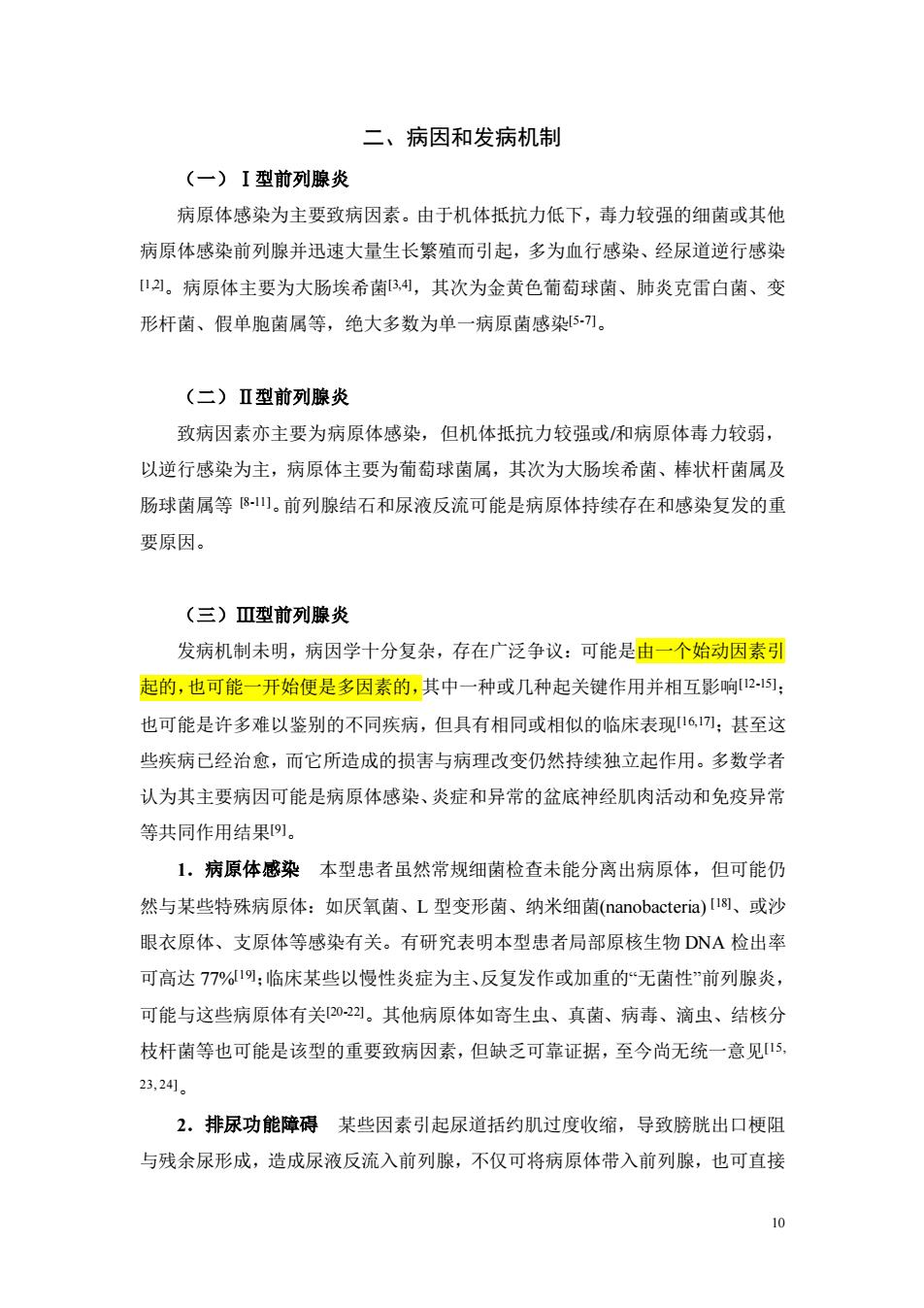
(1)一般人群中的患病率:由于应用不同的流行病学调查方法以及所选择 调查人群结构的不同,造成不同文献中报道的前列腺炎患病率有较大差异。在美 洲,20一79岁男性前列腺炎患病率为2.2%一16.0%16-20,在欧洲,20一59岁男 性前列腺炎患病率为14.2%7,在亚洲不同国家和地区,20~79岁的男性中前 列腺炎患病率为2.7%一8.7%22-2。在中国,15~60岁男性报告前列腺炎症状的 比例为84%26。 (2)组织学炎症的检出率:近年来研究发现良性前列腺增生的穿刺或手术 标本中组织学炎症的检出率达49.5%一100%27.30。 (3)尸检中的患病率:根据尸检报告,前列腺炎的患病率为24.3%~44.0% 132刘。研究发现,前列腺炎症状与组织学前列腺炎严重程度之间缺乏有临床意义 的相关性3。 2.前列腺炎发病的影响因素前列腺炎可以影响各个年龄段的成年男性。 50岁以下的成年男性患病率较高20234。此外,前列腺炎发病也可能与季节、饮 食、性活动、泌尿生殖道炎症、良性前列腺增生或下尿路综合征、职业、社会经 济状况以及精神心理因素等有关20.22,35飒。 参考文献 1.Drach GW,Fair WR,Meares EM,et al.Classification of benign diseases associated with prostatic pain:prostatitis or prostatodynia?[J].J Urol.1978.120:266 2.Krieger JN,Nyberg L,Nickel JC.NIH consensus definition and classification of prostatitis.[] JAMA,1999,282:236-237 3.Nickel JC,Nyberg LM,Hennenfent M Research guidelines for chronic prostatitis:consensus report from the first National Institutes of Health International Prostatitis Collaborative Network[]Urology,1999,54:9-233 4.Alexander RB.Trissel D.Chronic prostatitis results of an internet survey[]Urology,1996. 48568-574 5.Kiyota H Onodera S,Ohishi Y,et al.Questionnaire survey of Japanese urologists concerning the diagnosis and treatment of chronic prostatitis and chronic pelvic pain syndrome]Int J Urol. 2003,10.636-642 6.Schaeffer AJ,Knauss JS,Landis JR,et al.Leukocyte and bacterial counts do not correlate with 6
6 (1)一般人群中的患病率:由于应用不同的流行病学调查方法以及所选择 调查人群结构的不同,造成不同文献中报道的前列腺炎患病率有较大差异。在美 洲,20~79 岁男性前列腺炎患病率为 2.2%~16.0%[16-20],在欧洲,20~59 岁男 性前列腺炎患病率为 14.2%[17],在亚洲不同国家和地区,20~79 岁的男性中前 列腺炎患病率为 2.7%~8.7% [22-25]。在中国,15~60 岁男性报告前列腺炎症状的 比例为 8.4%[26]。 (2)组织学炎症的检出率:近年来研究发现良性前列腺增生的穿刺或手术 标本中组织学炎症的检出率达 49.5%~100%[27-30]。 (3)尸检中的患病率:根据尸检报告,前列腺炎的患病率为 24.3%~44.0% [31,32]。研究发现,前列腺炎症状与组织学前列腺炎严重程度之间缺乏有临床意义 的相关性[33]。 2. 前列腺炎发病的影响因素 前列腺炎可以影响各个年龄段的成年男性。 50 岁以下的成年男性患病率较高[20,23,34]。此外,前列腺炎发病也可能与季节、饮 食、性活动、泌尿生殖道炎症、良性前列腺增生或下尿路综合征、职业、社会经 济状况以及精神心理因素等有关[20-22,35,36]。 参考文献 1. Drach GW, Fair WR, Meares EM,et al. Classification of benign diseases associated with prostatic pain: prostatitis or prostatodynia?[J]. J Urol, 1978, 120:266 2. Krieger JN, Nyberg LJ, Nickel JC. NIH consensus definition and classification of prostatitis.[J] JAMA, 1999, 282:236-237 3. Nickel JC, Nyberg LM, Hennenfent M.Research guidelines for chronic prostatitis: consensus report from the first National Institutes of Health International Prostatitis Collaborative Network[J]. Urology, 1999, 54:229-233 4. Alexander RB, Trissel D. Chronic prostatitis: results of an internet survey[J]. Urology, 1996, 48:568-574 5. Kiyota H, Onodera S, Ohishi Y, et al. Questionnaire survey of Japanese urologists concerning the diagnosis and treatment of chronic prostatitis and chronic pelvic pain syndrome[J]. Int J Urol, 2003, 10:636-642 6. Schaeffer AJ, Knauss JS, Landis JR, et al. Leukocyte and bacterial counts do not correlate with

severity of symptoms in men with chronic prostatitis:the National Institutes of Health Chronic Prostatitis Cohort Study[J].J Urol,2002,168(3):1048-1053 7.Krieger JN Jacobs RR,Ross SO.Does the chronic prostatitis/pelvic pain syndrome differ from nonbacterial prostatitisand prostatodynia].164(5):1554-1558 8.Nickel JC,Downey Young I,et al Asymptomatic inflammation and/or infection in benign prostatic hyperplasia[BrJ Urol Int.1999.84:9761 9.Carver BS.Bozeman CB.Williams BJ,et al.The prevalence of men with National Institutes of Health category IV prostatitis and assocation with erm prostatic specific antigen[JUrol. 2003,169:589-591 10.Krieger JN,Riley DE,Cheah PY,et al.Epidemiology of prostatitis:new evidence for a world-wide problem[J].WorldJUrol.2003.2:70-74 11.Tripp DA,Nickel JC.Landist JR et al Predictor of quality of life and pain in chronic prostatitis/chronic pelvic pain syndrome:findings from the National Institutes of Health Chronic Prostatitis Cohort Study[J].Br J Urol Int,0,9:179-1282 12.Wenninger K.HeimanJR Rothman.Sickness impact of chronic nonbacterial prostatitis and its correlates[J]JUrol,199,15595-98 13.Calhoun EA MeNaughton Collins M.Pontari MA,et al.The economic impact of chronic prostatitisJ]Arch Inter Med,:131-123 14.Rizo M.Marchetti F.Travaglini F.et al Prevalence,diagnosis and treatment of prostatitis in Italy:a prospective urology outpatient practice study[J].BrJ Urol Int,2003,92955-959 15.Collins MM,Stafford RS.OLeary MP.et al.How common is prostatitis?A national survey of physician visits[JUrol,199.159:1-18 16.Collins MM,Stafford RS O'Leary MP.et al.Distinguishing chronic prostatitis and benign prostatic hyperplasia symptom:results of national survey of physician visits Urology1999 53:921-925 17.Roberts RO,Lieber MM,Rhodes T et al.Prevalence of a physician-assigned diagnosis of prostatitis:the Olmsted County Study of Urinary Symptoms and Health Status Among Men[J]. Urology,.1998,51:578-584 8.Nickel JC.Downey J.Hunter D.etal Prevalence of prostatitis-like symptoms ina population based study using the National Institutes of Health chronic prostatitis symptom index[J].J Urol. 7
7 severity of symptoms in men with chronic prostatitis: the National Institutes of Health Chronic Prostatitis Cohort Study[J]. J Urol, 2002, 168(3): 1048-1053 7. Krieger JN, Jacobs RR, Ross SO. Does the chronic prostatitis/pelvic pain syndrome differ from nonbacterial prostatitis and prostatodynia[J]. J Urol, 2000, 164(5):1554-1558 8. Nickel JC, Downey J, Young I, et al. Asymptomatic inflammation and/or infection in benign prostatic hyperplasia[J]. Br J Urol Int, 1999, 84:976-981 9. Carver BS, Bozeman CB, Williams BJ, et al. The prevalence of men with National Institutes of Health category IV prostatitis and association with serum prostatic specific antigen[J]. J Urol, 2003, 169:589-591 10. Krieger JN, Riley DE, Cheah PY, et al. Epidemiology of prostatitis: new evidence for a world-wide problem[J]. World J Urol, 2003, 2:70-74 11. Tripp DA, Nickel JC, Landist JR, et al. Predictor of quality of life and pain in chronic prostatitis/ chronic pelvic pain syndrome: findings from the National Institutes of Health Chronic Prostatitis Cohort Study[J]. Br J Urol Int, 2004, 94:1279-1282 12. Wenninger K, Heiman JR, Rothman I, et al. Sickness impact of chronic nonbacterial prostatitis and its correlates[J]. J Urol, 1996, 155:965-968 13. Calhoun EA, McNaughton Collins M, Pontari MA, et al. The economic impact of chronic prostatitis[J]. Arch Inter Med, 2004,164:1231-1236 14. Rizzo M, Marchetti F, Travaglini F, et al. Prevalence, diagnosis and treatment of prostatitis in Italy: a prospective urology outpatient practice study[J]. Br J Urol Int, 2003, 92:955-959 15. Collins MM, Stafford RS, O’Leary MP, et al. How common is prostatitis? A national survey of physician visits[J]. J Urol, 1998, 159:1224-1228 16. Collins MM, Stafford RS, O’Leary MP, et al. Distinguishing chronic prostatitis and benign prostatic hyperplasia symptoms: results of a national survey of physician visits[J]. Urology, 1999, 53:921-925 17. Roberts RO, Lieber MM, Rhodes T, et al. Prevalence of a physician-assigned diagnosis of prostatitis: the Olmsted County Study of Urinary Symptoms and Health Status Among Men[J]. Urology, 1998, 51:578-584 18. Nickel JC, Downey J, Hunter D, et al. Prevalence of prostatitis-like symptoms in a population based study using the National Institutes of Health chronic prostatitis symptom index[J]. J Urol

2001,165:842-845 19.Nickel JC.Downey JA,Nickel KR,et al Prostatitis-like symptoms:one year later[J].Br J Urol Int,.2002,90:678-681 20.Collins MM,Meigs JB.Barry MJ.et al.Prevalence and comrelates of prostatitis in the heath professionals follow-up study cohort[J].J Urol,2002,167:1363-1366 21.Mehik A.Hellstrom P.Lukkarinen O.et al.Epidemiology of prostatitis in Finnish men:a population-based cross-sectional study[]BrJ Urol Int,0.8:443-448 22.KuJH,Kim ME,Lee NK,et al.Influence of environmental factors on chronic prostatitis-like symptoms in young men:results of a community-based survey[J].Urology,2001,58:853-858 23.Tan JK.Png DJ,Liew LC.et al.Prevalence of prostatitis-like symptoms in Singapore:a population-based study[J].Singapore Medical Journal,002.3:189-193 24.Cheah PY,Liong MLYuen KH,et al Chronic prostatitis:symptoms survey with follow-up clinical evaluation[J].Urology,2003,61:60-64 25.Kunishima Y.Matsukawa M.TakahashiS.eta National institutes of health chronic prostatitis symptom index for Japanese men[].Urology,2002,60:74-77 26.Liang CC.LiHJ.WangZP.et a The prevalence of prostatitis-like symptoms in China] Urol,2009,182:558-563 27.Gerstenbluth RE,Steftel AD,MacLennan Distribution of chronic prostatitis in radical prostatectomy specimens with up-regulation of Bel2 in areas of inflammation Urol 2002,167(5):2267-2270 28.Nickel C.Downey J,YoungI,er Asymptomatic inflammation and/or infection in benign prostatic hyperplasia BJUInt,():976-981 29.Nickel JC.The overlapping lower uinary tract symptoms of benign prostatic hyperplasia and prostatitis.Current Opinion in Urology,2006,16(1):5-10 30.张祥华,张赛,李学松,等。良性前列腺增生合并组织学前列腺炎的检出率一两种不同 诊断标准的比较研究。中华临床医师杂志电子版,2007,1(7八:539-541 31.夏同礼,孔祥田,宓培,等,我国成人前列腺非特异性炎.中华泌尿外科杂志,1995, 16:711-713 32.MeMeal JE.Regional morphology and pathology of the prostate.AmClin Pathol,198 49347-357 8
8 2001, 165:842-845 19. Nickel JC, Downey JA, Nickel KR, et al. Prostatitis-like symptoms: one year later[J]. Br J Urol Int, 2002, 90:678-681 20. Collins MM, Meigs JB, Barry MJ, et al. Prevalence and correlates of prostatitis in the health professionals follow-up study cohort[J]. J Urol, 2002, 167:1363-1366 21. Mehik A, Hellstrom P, Lukkarinen O, et al. Epidemiology of prostatitis in Finnish men: a population-based cross-sectional study[J]. Br J Urol Int, 2000, 86:443-448 22. Ku JH, Kim ME, Lee NK, et al. Influence of environmental factors on chronic prostatitis-like symptoms in young men: results of a community-based survey[J]. Urology, 2001, 58:853-858 23. Tan JK, Png DJ, Liew LC, et al. Prevalence of prostatitis-like symptoms in Singapore: a population-based study[J]. Singapore Medical Journal, 2002, 43:189-193 24. Cheah PY, Liong ML, Yuen KH, et al. Chronic prostatitis: symptoms survey with follow-up clinical evaluation[J]. Urology, 2003, 61:60-64 25. Kunishima Y, Matsukawa M, Takahashi S, et al. National institutes of health chronic prostatitis symptom index for Japanese men[J]. Urology, 2002, 60:74-77 26.Liang CC, Li HJ, Wang ZP, et al. The prevalence of prostatitis-like symptoms in China[J]. J Urol, 2009, 182:558-563 27.Gerstenbluth RE , Steftel AD , MacLennan GT , et al . Distribution of chronic prostatitis in radical prostatectomy specimens with up-regulation of Bcl2 in areas of inflammation. J Urol , 2002, 167 (5) :2267-2270 28.Nickel JC, Downey J, Young I, et al. Asymptomatic inflammation and/or infection in benign prostatic hyperplasia. BJU Int,1999,84(9):976-981 29.Nickel JC. The overlapping lower urinary tract symptoms of benign prostatic hyperplasia and prostatitis. Current Opinion in Urology, 2006,16(1): 5-10 30.张祥华,张骞,李学松,等。 良性前列腺增生合并组织学前列腺炎的检出率——两种不同 诊断标准的比较研究。中华临床医师杂志(电子版),2007,1(7): 539-541 31. 夏同礼,孔祥田,宓培,等.我国成人前列腺非特异性炎[J].中华泌尿外科杂志, 1995, 16:711-713 32. McMeal JE. Regional morphology and pathology of the prostate[J]. Am J Clin Pathol, 1968, 49:347-357

33.Nickel JC.Roehrborn CG.O'Leary MP.et al.Examination of the relationship between symptoms of prostatitis and histological inflammation:Baseline data from the REDUCE chemoprevention trial[J].JUrol,2007,178:896-901 34.Liang CZ.Zhang XJ.Hao Y.et al An epidemiological study of patients with chronic prostatitis[].Br J Urol Int,2004,94:568-570 35.赵广明,韩贵夫,赵连华.汽车司机与慢性前列腺炎.男科学报,1999,5:176-177 36.Rothman I,Stanford JL KuniyukiA.et al Self-report of prostatitis and its risk factors in a random sample of middle-aged men[].Urology,004,64:876-879
9 33. Nickel JC, Roehrborn CG, O’Leary MP, et al. Examination of the relationship between symptoms of prostatitis and histological inflammation: Baseline data from the REDUCE chemoprevention trial[J]. J Urol, 2007, 178: 896-901 34. Liang CZ, Zhang XJ, Hao Y, et al. An epidemiological study of patients with chronic prostatitis[J]. Br J Urol Int, 2004, 94:568-570 35.赵广明,韩贵夫,赵连华.汽车司机与慢性前列腺炎[J].男科学报, 1999, 5:176-177 36. Rothman I, Stanford JL, Kuniyuki A, et al. Self-report of prostatitis and its risk factors in a random sample of middle-aged men[J]. Urology, 2004, 64:876-879

二、病因和发病机制 (一)I型前列腺炎 病原体感染为主要致病因素。由于机体抵抗力低下,毒力较强的细菌或其他 病原体感染前列腺并迅速大量生长繁殖而引起,多为血行感染、经尿道逆行感染 。病原体主要为大肠埃希菌,其次为金黄色葡萄球菌、肺炎克雷白菌、变 形杆菌、假单胞菌属等,绝大多数为单一病原菌感染5刃。 (二)Ⅱ型前列腺炎 致病因素亦主要为病原体感染,但机体抵抗力较强或/和病原体毒力较弱, 以逆行感染为主,病原体主要为葡萄球菌属,其次为大肠埃希菌、棒状杆菌属及 肠球菌属等山。前列腺结石和尿液反流可能是病原体持续存在和感染复发的重 要原因。 (三)Ⅲ型前列腺炎 发病机制未明,病因学十分复杂,存在广泛争议:可能是由一个始动因素引 起的,也可能一开始便是多因素的,其中一种或几种起关键作用并相互影响2: 也可能是许多难以鉴别的不同疾病,但具有相同或相似的临床表现6,1:甚至这 些疾病已经治愈,而它所造成的损害与病理改变仍然持续独立起作用。多数学者 认为其主要病因可能是病原体感染、炎症和异常的盆底神经肌肉活动和免疫异常 等共同作用结果例。 1.病原体感染本型患者虽然常规细菌检查未能分离出病原体,但可能仍 然与某些特殊病原体:如厌氧菌、L型变形菌、纳米细菌(nanobacteria)【l网、或沙 眼衣原体、支原体等感染有关。有研究表明本型患者局部原核生物DNA检出率 可高达77%1吻:临床某些以慢性炎症为主、反复发作或加重的“无菌性前列腺炎, 可能与这些病原体有关02。其他病原体如寄生虫、真菌、病毒、滴虫、结核分 枝杆菌等也可能是该型的重要致病因素,但缺乏可靠证据,至今尚无统一意见5, 23,24。 2.排尿功能障碍某些因素引起尿道括约肌过度收缩,导致膀胱出口梗阻 与残余尿形成,造成尿液反流入前列腺,不仅可将病原体带入前列腺,也可直接
10 二、病因和发病机制 (一)Ⅰ型前列腺炎 病原体感染为主要致病因素。由于机体抵抗力低下,毒力较强的细菌或其他 病原体感染前列腺并迅速大量生长繁殖而引起,多为血行感染、经尿道逆行感染 [1,2]。病原体主要为大肠埃希菌[3,4],其次为金黄色葡萄球菌、肺炎克雷白菌、变 形杆菌、假单胞菌属等,绝大多数为单一病原菌感染[5-7]。 (二)Ⅱ型前列腺炎 致病因素亦主要为病原体感染,但机体抵抗力较强或/和病原体毒力较弱, 以逆行感染为主,病原体主要为葡萄球菌属,其次为大肠埃希菌、棒状杆菌属及 肠球菌属等 [8-11]。前列腺结石和尿液反流可能是病原体持续存在和感染复发的重 要原因。 (三)Ⅲ型前列腺炎 发病机制未明,病因学十分复杂,存在广泛争议:可能是由一个始动因素引 起的,也可能一开始便是多因素的,其中一种或几种起关键作用并相互影响[12-15]; 也可能是许多难以鉴别的不同疾病,但具有相同或相似的临床表现[16,17];甚至这 些疾病已经治愈,而它所造成的损害与病理改变仍然持续独立起作用。多数学者 认为其主要病因可能是病原体感染、炎症和异常的盆底神经肌肉活动和免疫异常 等共同作用结果[9]。 1.病原体感染 本型患者虽然常规细菌检查未能分离出病原体,但可能仍 然与某些特殊病原体:如厌氧菌、L 型变形菌、纳米细菌(nanobacteria) [18]、或沙 眼衣原体、支原体等感染有关。有研究表明本型患者局部原核生物 DNA 检出率 可高达 77%[19];临床某些以慢性炎症为主、反复发作或加重的“无菌性”前列腺炎, 可能与这些病原体有关[20-22]。其他病原体如寄生虫、真菌、病毒、滴虫、结核分 枝杆菌等也可能是该型的重要致病因素,但缺乏可靠证据,至今尚无统一意见[15, 23, 24]。 2.排尿功能障碍 某些因素引起尿道括约肌过度收缩,导致膀胱出口梗阻 与残余尿形成,造成尿液反流入前列腺,不仅可将病原体带入前列腺,也可直接